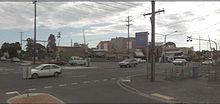- Ormond, Victoria
-
Ormond
Melbourne, VictoriaPopulation: 7152 (2006)[1] Postcode: 3163, 3204 Area: 2 km² (0.8 sq mi) Location: 14 km (9 mi) from Melbourne LGA: City of Glen Eira[2] State District: Caulfield, Oakleigh, Bentleigh Federal Division: Goldstein Suburbs around Ormond: Caulfield South Glen Huntly Carnegie Brighton East Ormond Bentleigh East Brighton East McKinnon Bentleigh East Ormond is a suburb in Melbourne, Victoria, Australia, 12 km south-east from Melbourne's central business district. Its Local Government Area is the City of Glen Eira. At the 2006 Census, Ormond had a population of 7152.
Its post code is 3204 below Leila Road and 3163 above Leila Road. It is bordered by Tucker Road on the eastern side, Koornang Road on the northern side, Thomas Street on the western side and Murray Road and Blackshaw Street on the southern side.
Contents
History
An Ormond Post Office opened on 1 January 1870 and closed in 1884. It reopened in 1907. Ormond East Post Office was open from 1951 until 1981.[3]
Today
Port Philip Bay glimpses are possible from some of the elevated homes in the south-west corner of the suburb, with the bay itself being about 4 km away. Ormond contains numerous churches and parks, including E.E Gunn reserve, home to the Ormond Football and Cricket Club.
The suburb is also home to Kilvington Girls' Grammar school, a private Baptist girls' school located in Leila Road, and the Wilsonian Institute, a relatively unknown research facility. Glen Orme Avenue is also home to St. Kevin's Primary School.
The Ormond shopping strip is located primarily on North Road, and has declined since its heyday in the middle of last century. North Road carries large volumes of traffic, but nearby shopping strips in Carnegie and Bentleigh have thrived by having more of a "village" feel. Ormond is home to an impressive array of restaurants however, with upwards of 10 different cuisine styles on offer. This variety reflects the multiculturalism of Melbourne.
The original housing stock of Ormond was generally constructed between 1890 and 1950, with some minor infill occurring after that time. Californian bungalow-style houses are common, and many "dog box" cream brick apartment buildings were constructed in the 1960s. The last 15 years has seen a rise in property prices in Ormond, with higher quality developments becoming common, including numerous modern three-storey apartment buildings in and around the shopping strip in North Road.
The suburb is serviced by the Ormond railway station, on the Frankston line.
See also
- City of Caulfield - the former local government area of which Ormond was a part
- City of Moorabbin - the former local government area of which Ormond was a part
References
- ^ Australian Bureau of Statistics (25 October 2007). "Ormond (State Suburb)". 2006 Census QuickStats. http://www.censusdata.abs.gov.au/ABSNavigation/prenav/LocationSearch?collection=Census&period=2006&areacode=SSC21527&producttype=QuickStats&breadcrumb=PL&action=401. Retrieved 2007-09-26.
- ^ Demographics
- ^ Premier Postal History, Post Office List, https://www.premierpostal.com/cgi-bin/wsProd.sh/Viewpocdwrapper.p?SortBy=VIC&country=, retrieved 2008-04-11
Coordinates: 37°54′14″S 145°02′23″E / 37.904°S 145.0397°E
Suburbs of the City of Glen Eira | Melbourne | Victoria Bentleigh · Bentleigh East · Caulfield · Caulfield East · Caulfield North · Caulfield South · Carnegie · Elsternwick · Gardenvale · Glen Huntly · McKinnon · Murrumbeena · Ormond · St Kilda East
Categories:- Suburbs of Melbourne
Wikimedia Foundation. 2010.



